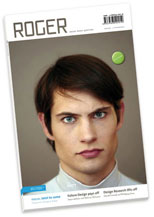
Wie auch schon im letzten Jahr, bot die IMM jungen Designern und Hochschulen im Rahmen der „design talents“ ein Forum, ihre Konzepte, Prototypen und Produkte einem internationalen Fachpublikum vorzustellen.
Unter dem Motto: "one spirit, three events", konnte man in der Messehalle 1 neben bekannten Formaten wie dem Nachwuchswettbewerb „inspired by cologne“ und dem „future point“, auch viele selbstständige Jungdesigner mit fertigen Produktreihen finden.
In anbetracht der Tatsache, mit welch großen Worten die IMM ihre „ Arena für kreative Köpfe“ im Vorfeld bewarb, war man geneigt davon auszugehen hier ein Highlight der Messe vorfinden zu können.
Erstmalig war das Online-Portal „Designspotter“ auf der Messe vertreten, welches ca.50 Jungdesignern unter seiner Dachmarke ein geschlossenes Auftreten ermöglichte. In diesem Kontext fanden auch kleinere Produktreihen ein Forum, für die sich ein seperater Messestand nicht rentieren würde. Eine gute Sache und es wäre wünschenswert, wenn sich derartige Kooperationsprojekte auf der IMM etablieren können.
Neben Designspotter versuchten auch ca. 20 Einzelaussteller die Aufmerksamkeit des Publikums auf ihre Stände zu lenken.
Erfolgreich gelang dies der Firma Designatics, welche mit ihrem „Sonic Chair“ ein ausgereiftes und markttaugliches Produkt vorstellten. Auch die Schmetterlinge von Vanessa Hannen sind zu erwähnen, da sie gut produziert und wirklich hübsch sind. Nicht hübsch aber dafür interressant waren die Dosenlampen von Christian Lessing. Interressant vor allem deshalb, weil man sich fragen musste, wie man es schafft mit einem solchen Produkt auf die Messe zu kommen.
>> future point 
Überraschend fiel der Auftriit der Hochschulen unter dem Motto „future point“ aus.
Zum Beispiel staunte man nicht schlecht über die Exponate der „Anadolu University“. Der Ausdruck einer „Röntgenlampe“ gepaart mit mangelhafter Umsetzung ließ keine Fragen offen, außer vielleicht, was so eine Dosenlampe wohl kosten mag. Während sich an diesem Stand auch interressante Produktideen fanden, glänzten manche Hochschulen mit vornehmer Zurückhaltung. Die Stände der FH Rosenheim und HTF Stuttgart beispielsweise, präsentierten weder besonders aufsehenerregende Exponate, noch überzeugten sie durch innovative, mutige Konzepte oder besondere Kommunikationsbereitschaft. Welche konkreten Ziele mit ihrem Auftritt erreicht werden sollten wird ihr Geheimniss bleiben, zumal es Andere besser verstanden die Neugier des Besuchers zu wecken. So zum Beispiel das „Designlabor Bremen“, welches mittels einer raumübergreifenden Installation für ihr Stipendienprogramm warb. Interessierte Hochschulabsolventen konnten sich bewerben, indem sie sich photographieren ließen und das so entstandene Portrait über neonfarbene Schnüre mit dem Projekt in Verbindung brachten.
Außergewöhnlich und optisch ansprechend war der Messestand der Staatlichen Hochschule für Gestaltung Karlsruhe. Der Mut, den Messestand mit Folie zu verhüllen, um so neugierig zu machen und auf eine Entdeckungsreise einzuladen, wurde jedoch nicht belohnt. Vermutlich, weil man diese Form der Präsentation für sich selbst sprechen ließ, ohne den Besucher zusätzlich zu animieren.
InspiredWäre noch der Nachwuchswettbewerb für junge Designtalente „inspired by cologne“ zu erwähnen.
Zum einen gab es dort richtig gute Ideen und Produkte zu sehen, zum anderen aber auch solche bei denen man sich wünschte der Erschaffer(in) hätte die inspiration besser für ein schönes Bild genutzt.
Zur ersten Gruppe gehört auf jeden Fall der „Radiator“ von Marco Dessi. Dieser überzeugt nicht nur durch seine außergewöhnliche Formsprache, sondern auch durch seine Funktionalität. Eine Heizung wird hier zum architektonischen Spielobjekt und eröffnet individuelle Gestaltungsfreiheit.

Auf moderne Technologie in Verbindung mit futuristischer Gestaltung setzt Simon Brünner mit seiner Leuchte „Ufo“. Er kombiniert die lichtleitende Eigenschaft von Glasfasern und Acrylglas zu einem außergewöhnlichen Einrichtungsobjekt.
Ganz im Gegensatz zu Katrin Greilings Leuchte „Bird“. Auch aus Acrylglas, scheinen hier die Ansprüche an Ästhetik und Funktion eher zweitrangig zu sein. Weder spendet diese Leuchte Licht, noch erinnert sie an einen Vogel.Falls doch sollte dem armen Tier geholfen werden.
Weniger ist mehr dachte sich wahrscheinlich Marina Weddeling. Sie halbierte gewöhnliche Holzstühle und dübelte sie auf Bodenniveau an eine Wand. So hatte sie weniger Stühle, aber dafür eine neue Garderobe mit integrierter Ablage, die sie „Schmalhans“ taufte.
FazitAlles in allem war die Ausstellung „design talents“ einen Besuch wert. Man muss jedoch sagen, dass der Gesamteindruck durchaus besser hätte ausfallen können. In Anbetracht des relativ beschränkten Budgets, vieler dort vertretener Aussteller, war der Anspruch aus einer emotionslosen Messehalle eine „Kreativ-Areana“ zu machen, zu hoch angesetzt. Die Schaffung einer authentischen Atmosphäre, würde jedoch den Vorsatz junges Design attraktiv zu präsentieren unterstützen.
Man könnte sich aber auch die Frage stellen, ob junges Design überhaupt gut auf der Messe aufgehoben sein kann und sich nicht eher in ausgewählten, lebendigeren, städtischen Strukturen präsentieren sollte?
























